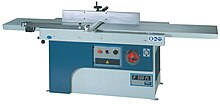Surface planer
The planer or short jointer is a metal-cutting machine tools for woodworking . It is mainly used for smoothing and leveling ( dressing ), for producing angular edges and for preparing width connections ( joining ) in solid wood .
construction
The machine body houses the drive unit, the planer shaft, in which two or more planer knives are used, and the two adjustable planer tables. The surface of the removal table is set at the height of the knife flight circle, while the receiving table is adjusted below the height of the knife flight circle. The difference in height between the up and down table determines the chip removal on the workpiece. The dressing stop serves as a stop to bring the surfaces of the workpiece into a defined angle. It is usually adjustable from 90 ° to 45 °. A planer shaft guard serves as a safety device, i.e. an adjustable cover for the planer shaft, which is intended to protect against unintentional contact of the user with the rotating planer shaft.
There are three common devices (equipment depends heavily on the age of the machine!)
- Flap protection with joining strip: This protection consists of many wooden flaps connected by means of hinges.
- Link vibration protection: swings to the side when touched and releases the cutterblock. The disadvantage of this protection is that the shaft is released early in the case of wide workpieces, which increases the risk of accidents.
- Protection Bridge: This is the newest and most secure facility out there. It always covers the shaft, regardless of the workpiece width, etc. It is only released when the workpiece is approached against a stop mounted on the guard.
Sometimes surface planers can be expanded to include a horizontal or slot hole drilling device. For this purpose, a drill chuck is mounted on the accessible end of the cutterblock and an adjustable workpiece support is mounted in front of the machine.
So-called surface planing and thicknessing machines are also in use , i.e. H. Combined machines that can be converted into a planer by folding up the planing tables.
Working method
To produce a rectangular workpiece, the planer is usually used to plan a piece of wood cut to size on a sliding table saw on two adjacent sides and bring it into a right angle (90 °).
The following work steps are necessary:
- Dressing - One side of the squared timber is dressed (without using the dressing stop) - this creates a flat surface that serves as the starting surface for the further processing steps.
- Abut the angular edge - A second surface adjacent to the first is dressed by placing the first surface that has already been planed against the planing fence and guiding the workpiece over the planer shaft and thus planing it.
The result is squared timber planed on both sides with surfaces that are neatly at right angles to one another. Further processing takes place on the thickness planer .
When joining , two opposite sides of wood are planed at an angle to produce surfaces that are glued across the width.
Web links
- Summary of safety devices on surface planing machines and certain work steps ( memento of March 10, 2007 in the Internet Archive ) earlier online at www.schreiner-seiten.de , accessed on October 7, 2015
Individual evidence
- ↑ a b c Wolfgang Nutsch and others; Expertise for joiners , 12th edition, Verlag Europa-Lehrmittel OHG, Wuppertal 1980, pages 276–279, ISBN 3-8085-4011-7

